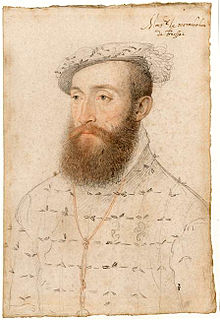Jean de Monchy
At this time the kingdom regained control of Boulogne and the new king Henri II appointed him governor of the important port city.
In 1557 the French were faced with disaster at the Saint-Quentin and in the aftermath Sénarpont enjoyed command as temporary lieutenant-general of maritime Picardie.
He was charged in September 1560 with leading negotiations over the exact borders with Spanish Vlaanderen, however the commission ultimately wasn't able to conclude much before it was overtaken by various disorders.
[10][14] Therefore, Henri instructed the governor the duc de Vendôme to look to Sénarpont and Villebon for advice on how to navigate through the situation.
[17] In the absence of other commanders, Henri took personal responsibility for some military arrangements, coordinating with the governor of Péronne Humières for the provision of pioneers to work on the walls of the city.
[20] Sénarpont wrote to the recently returned Guise on 12 October from his governate, expressing his desire to devote his property and life in the grandee's service.
He reported to the conseil privé (privy council) which was residing in Compiègne on 21 November that the defences of the city were weak.
Henri proposed a winter attack of Calais, both for the surprise factor but also because the French mercenary forces could be used before their contract expired.
[23] Due to this scepticism, Sénarpont was again dispatched to conduct reconnaissance, this time with the respected engineer Piero Strozzi, they arrived in mid-November, inspecting the area while disguised as poor people.
[23] Sénarpont wrote to Guise that to ensure the English did not suspect that anything was being planned he was going to return to his seigneurie and let the rumour spread that he intended to winter there.
[24] Henri was pleased by the assessment of Strozzi/Sénarpont and responded to the criticism of the winter conditions that the freezing weather of January was necessary to combat the marshes that surround the city.
Several warships were gathered in Sénarpont's city of Boulogne, to unite with forty transports that were held in the Somme, these were to blockade Calais so that no reinforcements might arrive (this was accomplished without suspicions from the English).
He conducted his inspection alongside his various lieutenants: his brother the duc d'Aumale, Marshal Thermes, Strozzi, the grand maître de l'artillerie (grandmaster of the artillery) D'Andelot and Sénarpont.
[27] In April Villebon departed for court, keen to secure permission from the king to take leave of his responsibilities and return to his estates.
De Thermes took a force out of French Calais into Vlaanderen to divert Spanish attention from the Luxembourg attack.
An English fleet joined the fray savaging one of De Thermes' wings and the army was annihilated, only a small force making it back to the safety of Calais.
[29] Though the Peace of Cateau-Cambrésis had ended the Italian Wars, it did not bring about the immediate release of all the prisoners in French and Spanish captivity.
Coligny was, due to his eclectic responsibilities unable to be an active and present governor, and therefore Sénarpont did the majority of the work of governing the province.
[5][34] It would in fact by the more reliably Catholic comte de Brissac who assumed the governorship upon Coligny's resignation in January 1560.
The aim was to address the specifics of the border between French Picardie and Spanish Vlaanderen, which had been left somewhat vague at the larger peace conference.
[39] In September 1560, rumours swirled that a coalition of aristocratic opponents against the house of Lorraine's control of the kingdom had formed.
At this time Condé's involvement in the Conspiracy of Amboise led to him being detained by the Lorraine government, he would be released with the death of François II.
[44] Sénarpont for his part was suspected of at least being sympathetic to Protestantism after the preaching tour of John Knox in Dieppe in 1559 if not a Protestant himself.
[5] In May, Sénarpont made an attempt to capture Calais, however this was a failure and he was stopped from his purposes by a governor under the authority of Cardinal de Bourbon.






